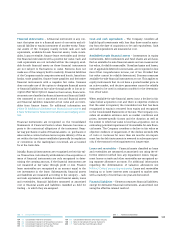Siemens 2011 Annual Report Download - page 273
Download and view the complete annual report
Please find page 273 of the 2011 Siemens annual report below. You can navigate through the pages in the report by either clicking on the pages listed below, or by using the keyword search tool below to find specific information within the annual report.
153 D. Consolidated Financial Statements 273 E. Additional information
158 D. Consolidated Statements of Changes in Equity
160 D. Notes to Consolidated Financial Statements
266 D. Supervisory Board and Managing Board
154 D. Consolidated Statements of Income
155 D. Consolidated Statements of Comprehensive Income
156 D. Consolidated Statements of Financial Position
157 D. Consolidated Statements of Cash Flow
ning on or after January , ; early adoption is permitted.
Nevertheless, the IASB issued an exposure draft in August
proposing to postpone the effective date of IFRS to an-
nual reporting periods beginning on or after January , .
It is expected that the exposure draft will be implemented.
The delay is owed to the still outstanding publication of phas-
es (impairment) and (hedge accounting) of IFRS . The
European Financial Reporting Advisory Group already had
postponed its endorsement advice, to take more time to con-
sider the output from the IASB project to improve accounting
for financial instruments. The Company is currently assessing
the impacts of the adoption on the Company ’s Consolidated
Financial Statements.
The IASB issued various other pronouncements. These recent-
ly adopted pronouncements as well as pronouncements not
yet adopted did not have a material impact on Siemens’ Con-
solidated Financial Statements.
– Critical accounting estimates
Siemens’ Consolidated Financial Statements are prepared in
accordance with IFRS as issued by the IASB and as adopted by
the EU. Siemens’ significant accounting policies, as described
in
Note
Summary of significant accounting policies are es-
sential to understanding the Company ’s results of operations,
financial positions and cash flows. Certain of these account-
ing policies require critical accounting estimates that involve
complex and subjective judgments and the use of assump-
tions, some of which may be for matters that are inherently
uncertain and susceptible to change. Such critical accounting
estimates could change from period to period and have a ma-
terial impact on the Company ’s results of operations, financial
positions and cash flows. Critical accounting estimates could
also involve estimates where management reasonably could
have used a different estimate in the current accounting peri-
od. Management cautions that future events often vary from
forecasts and that estimates routinely require adjustment.
Revenue recognition on construction contracts – The Com-
pany ’s Sectors, particularly Energy and Industry, conduct a
significant portion of their business under construction con-
tracts with customers. The Company generally accounts for
construction projects using the percentage-of-completion
method, recognizing revenue as performance on contract
progresses. Certain long-term service contracts are accounted
for under the percentage-of-completion method as well. This
method places considerable importance on accurate esti-
mates of the extent of progress towards completion and may
involve estimates on the scope of deliveries and services re-
quired for fulfilling the contractually defined obligations. De-
pending on the methodology to determine contract progress,
the significant estimates include total contract costs, remain-
ing costs to completion, total contract revenues, contract
risks and other judgments. Management of the operating Di-
visions continually reviews all estimates involved in such con-
struction contracts, including commercial feasibility, and ad-
justs them as necessary. Under the percentage-of-completion
method, such changes in estimates may lead to an increase or
decrease of revenues in the respective reporting period. The
Company also uses the percentage-of-completion method for
projects financed directly or indirectly by Siemens. In order to
qualify for such accounting, the credit quality of the customer
must meet certain minimum parameters as evidenced by the
customer’s credit rating or by a credit analysis performed by
Financial Services (SFS).
At a minimum, a customer’s credit
rating must be single B or B respectively from external rating
agencies or an equivalent SFS-determined rating. In cases the
inflow of economic benefits is not probable due to customer
related credit risks the revenue is restricted to the amount of
payments irrevocably received. The Company believes the
credit factors used provide a reasonable basis for assessing
credit quality.
Trade and other receivables – The allowance for doubtful
accounts involves significant management judgment and re-
view of individual receivables based on individual customer
creditworthiness, current economic trends and analysis of
historical bad debts on a portfolio basis. For the determina-
tion of the country-specific component of the individual al-
lowance, we also consider country credit ratings, which are
centrally determined based on information from external rat-
ing agencies. Regarding the determination of the valuation al-
lowance derived from a portfolio-based analysis of historical
bad debts, a decline of receivables in volume results in a cor-
responding reduction of such provisions and vice versa. As of
September , and , Siemens recorded a total valua-
tion allowance for accounts receivable of €, million and
€, million, respectively.
Impairment – Siemens tests at least annually whether good-
will has incurred any impairment, in accordance with its ac-
counting policy. The determination of the recoverable amount
of a cash-generating unit to which goodwill is allocated in-
volves the use of estimates by management. The outcome
























